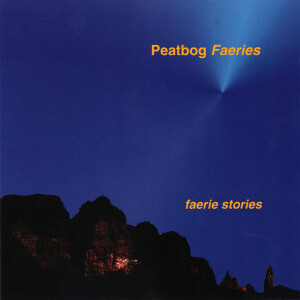 Chris Woods penned this review.
Chris Woods penned this review.
When I first heard this album, I assumed the Peatbog Faeries were from the Northern Isles of Scotland. Somehow, probably because of Shooglenifty and the slightly less trance-styled Drop the Box, I have come to assume the northern isles to be the home of dance/trance Celtic. A glance at the insert however soon put me right; it was mostly composed and recorded on the Isle of Skye in a home studio, before being remixed and tidied up on the mainland.
It has been a couple of years since their first Mellowosity album; and while it would have been nice to have had the next album sooner, this one certainly makes up for the wait. I’m tempted to simply say “If you like Shooglenifty, Afro Celt and similar trance/dance/atmospheric/new age instrumental roots bands then get a copy of this, it’s every bit as good” and stop writing now! Okay, I won’t. I’ll say a little more about it, but basically that’s the message.
The Peatbog Faeries are a six-piece band: Peter Morrisson on pipes and whistles; Ben Ivitsky on fiddle, throat singing and triangle; Innes Hutton on bass, percussion and bodhran; Iain Copeland on drums, sampling and logic audio; Ali Pentland on guitar, mandolin and octavious; and lastly Nurudin, who is credited with keyboards and general weirdness. As you can see, they play a mix of traditional and modern instruments, which is exactly what comes through in the music. The drums, bass and keyboards are very much club-mix dance/trance/New Age, while the Celtic and traditional-sounding instruments play over them to create the melodies and atmosphere and make the music flow. Obviously it’s not quite that simple. After all it took these expert musicians two years to get it sounding this good. I find that sometimes, all too often in fact, these types of musical blends can be difficult to listen to. They tend towards self-indulgence, great fun for the musicians but a disjointed listening experience. Not so in this case: all the tracks on the album have easily recognizable melodies and a disciplined structure which allows Nurudin’s “general weirdness” to create atmosphere, adding to the listening experience and complexity of the sound without distracting from it. Simple enough to sound good on the first listen and complex and clever enough to improve with more listening, an ideal combination!
Make no mistake this is powerful music. The drums and rhythm are insistent and overlaid with swirling highland bagpipes fiddle or keyboards. It’s very loud and very lively. Despite the modern rhythm sound and the keyboards, it is very undeniably and unmistakably Scottish, incorporating quite a number of traditional tunes and others written to a traditional template. Even playing the album quietly at home, there is no way to prevent feet tapping and body swaying around in time with it.
I am not going to even attempt a track-by-track list. There are tracks, 11 of them, all instrumental, to be exact, and some have rather amusing names like “The Folk Police” and “Get your Frets Off.” While the tracks are separate, the album, when you listen to it, is much more a whole experience than just a collection of separate tracks. It plays for well over an hour, slipping and flowing effortlessly from track to track, theme to theme and style to style. There are loud passages, quieter passages, traditional-sounding sections, a little bit of weirdness, the occasional unexpected and some surprising gentle, almost tender moments.
Folk traditionalists will of course hate this type of music. They would probably be perfectly happy with the pipes, bagpipes, guitar, bodhran and fiddle, all of which are sometimes played in traditional style, but I think the “Folk Police” would have trouble with the rhythm section which borrows freely from jazz, dub and rock. For the younger listener and other folk fans with open minds (among which I like to consider myself), this blend of ancient and modern not only gives some street cred to traditional music but displays it in a totally new and often amazingly flattering light. Bagpipes actually sound good against this type of rhythm, and it all fits together flawlessly. One can’t help but wonder how the authors of some of these traditional tunes would have played them had they had modern music technology at their disposal?
In keeping with the increasing trend in the folk field There are sound file downloads so you can hear how skilled this album is as well as more information about the band. The site is well worth a look and a listen, plus it has useful links to some other Scottish band and music pages.
(KRL, 2000)
